HP Mini 5103: Looking at the Dual-Core Atom N550
by Jarred Walton on December 17, 2010 1:05 PM ESTHP Mini 5103 LCD
The LCD is one of the toughest things to evaluate on this particular netbook. We know many people are looking for better than WSVGA (1024x600) resolution on netbooks, and here we have exactly that. You also get a multi-touch display as a potential bonus, but my experience with this particular display was less than ideal. Now we get to the actual numbers using hardware measurements, and the results don’t necessarily jive with my subjective impression. For one, the touch surface really adds an undesirable “sparkle” effect that the numbers just don’t reflect. Another point of contention is the colors; the 52.2% gamut actually puts it quite a bit higher than netbooks like the 5102, 1001P, etc. but it just doesn’t look that great. A lot of that probably goes back to the contrast ratio, however, where we measure less than 200:1 yet again, among the worst scores in our recent history—and joined by the HP Mini 311 and 5102.
Ultimately, this is just one particular LCD we’re evaluating, and it’s not even an option on the HP site anymore. The resolution is a nice change of pace, but everywhere else the LCD falls short. If you really like touchscreen interfaces, it might suit you well, and it might show up on the configurator again in the future. We just wish more laptop LCDs—yes, even LCDs on inexpensive netbooks—could look more like the ASUS 1001P or the MacBook Pro 13.
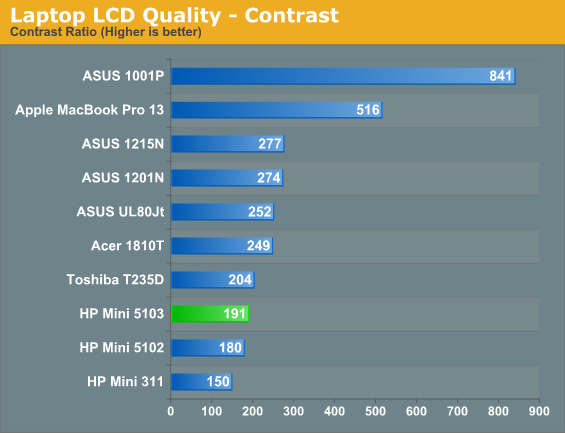
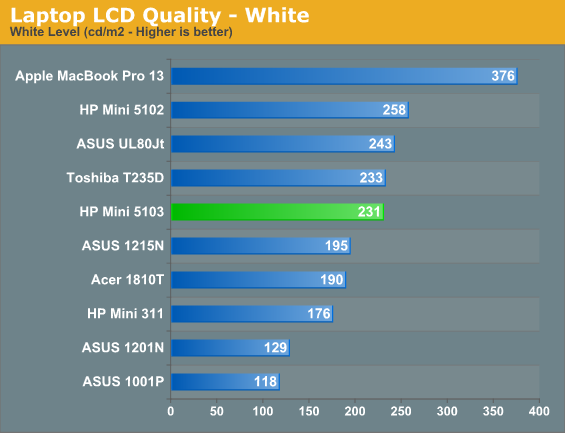
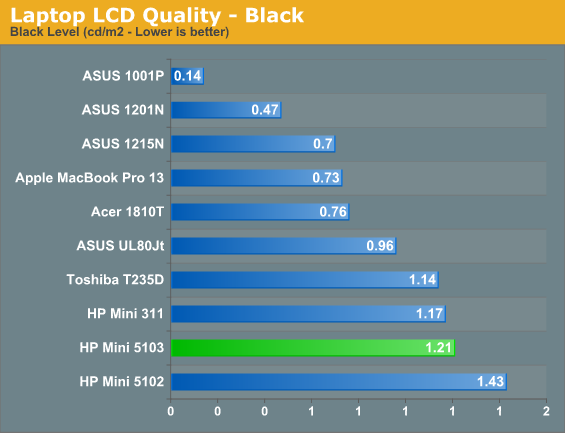
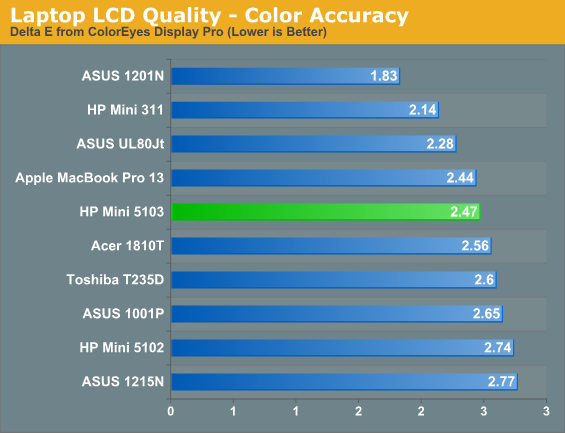
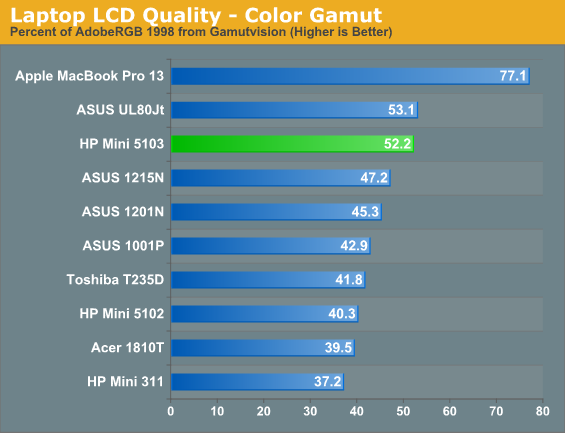
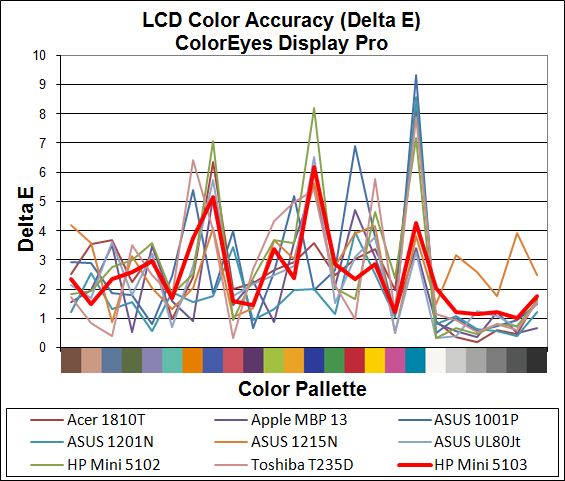

















57 Comments
View All Comments
seanleeforever - Monday, December 20, 2010 - link
your logic is flawed.instead of spending money on laptop/desktop/netbook and what have you, and only uses 1/4 of your investment every time, you could simply buy a ultra portable, and use your investment 100% of time. (not to mention the hassle of migrate files, sync folder and what not).
my x201 tablet weights about 3 lbs, 7 hr battery life, i7 core, ssd and IPS. small, light, portable (very portable because it is a tablet), and process 1080p flash and still have 60% of cpu power to do other stuff.
sure it is costly on the paper (about 10 time more expensive than my HP Mini 210), but i use it 100% of time.
synaesthetic - Monday, December 20, 2010 - link
I disagree with netbooks being portable. They're more portable, but when I had a netbook and a desktop compared to having just a full-size laptop, I used my netbook no more often than I use my laptop now. It was not any easier to quickly check something, because I still had to boot it... wait for the OS to start... be near a wifi connection... etc.My smartphone fills the portability niche.
LoneWolf15 - Monday, December 20, 2010 - link
I just got a Dell Latitude E4200 from their Outlet for $690 after tax. That includes the following:SU9600 processor
2GB RAM
12.1" 1200x800 matte display with full-size keyboard
64GB SSD and external eSATA DVD writer
Six-cell battery
The HP netbook is pretty cool if you want new, but I got a 3-year warranty with the Latitude, but when I can get a $1700 ultraportable as a certified-refurb for about the same as the HP, and it performs faster and has superior construction quality (not that the HP is bad, just the Latitude is killer), then the Latitude wins. I was also able to easily add a WWAN card after the fact.
Still, HP is moving in the right direction with this. I hope more vendors will do so.
Guspaz - Monday, December 20, 2010 - link
Atom has been on the market for almost three years now, and despite this fact, no significant advances have been made in power efficiency or performance.Compare the Atom 330, which came out in mid 2008 to the N550, reviewed today. Their power draw is about the same (8.5W versus 8W), and their performance and clockspeed is about the same (1.6GHz versus 1.5GHz).
Atom was underpowered when it was released, but fast enough to be useful. Today, performance is about the same, but the demands placed on it are higher. The end result is that Atom just gets worse and worse.
ULV products are a lot more interesting.
JarredWalton - Monday, December 20, 2010 - link
The only problem with your post is that the Atom 330 didn't have SpeedStep, it didn't have an IGP, and it didn't have DDR3 support. We looked at the ASUS 1201N way back in the day with Atom 330 + ION, and because of the lack of SpeedStep the battery life was about half of what you can now do with the N550. But the rest of what you say is true, and I really hope the next Atom revision does more to improve the status of netbooks.synaesthetic - Monday, December 20, 2010 - link
I'm afraid it won't, because Intel has already spent a great deal of time badmouthing netbooks as primary computing devices. They don't want netbooks to compete with their more expensive mobile processor lines. Hell, this is why they killed the SU2300 in the first place; because Acer was selling Aspire 1410s with that chip for $400 and it was selling like hotcakes, scarcely slower than the more expensive CULV chips!JarredWalton - Thursday, December 23, 2010 - link
I'm not so sure about your "simple math", rarson. The 5103 has a 29Wh battery, not a 66Wh battery (that upgrade is available, but it's not what I tested).Based on the figures in my review, at idle the Mini 5103 uses just 6.8W total. In the Internet test it uses 9.0W, and in the x264 test (the "worst case" scenario) it hits 12.9W. Of course, those are all on battery power, and I'd assume there's some inefficiency in getting power out of the battery and into the system.
As a secondary test, I just plugged the Mini 5103 into a Kill-A-Watt device to test power draw. Power adapter efficiency certainly comes into play in this test, and if it's 80% efficient (reasonable) the actual power draw is pretty close to the above calculations.
Idle: 10W
x264 playback: 13.5W
Cinebench SMP: 15W
So, again, TDP doesn't necessarily tell you a whole lot. Idle power requirements are much lower than TDP, and even heavy use will rarely hit TDP on everything, so you can't just add CPU, chipset, HDD, etc. TDPs to figure out how much power a system will actually use.